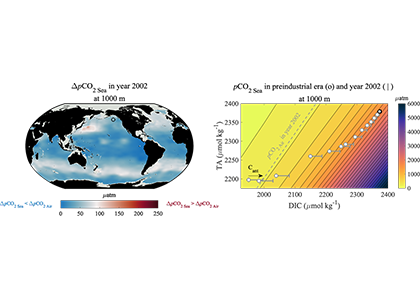Ocean Acidification (OA), caused by the air-to-sea transfer of anthropogenic carbon (Cant), is intuitively thought to be a surface-intensified process, which makes sense because the concentration of Cant is greatest near the ocean surface and decreases with depth. But this intuition is not correct for multiple metrics of OA that are less commonly studied below the sea surface, including the partial pressure of carbon dioxide gas (pCO2) and the hydrogen ion concentration ([H+]).
We braved the quiescent seas of a three-dimensionally mapped data product (Lauvest et al., 2016) hunting for signals of OA in the deep. Just like anyone who seeks moss in Seattle, we were successful. We identified massive interior ocean changes in pCO2 and [H+] caused by the accumulation of Cant (up to the year 2002). Such signals were not clearly identifiable for the more commonly studied pH and aragonite saturation state OA metrics. Extreme pCO2 and [H+] changes induced by smaller amounts of Cant at depth are caused by greater sensitivities of these parameters to carbon addition in subsurface waters that are weakly buffered because they have experienced significant organic matter respiration. This results in mesopelagic pCO2 (and [H+]) changes that are more than twice as large as overlying surface water changes throughout large expanses of the ocean, outpacing the atmospheric pCO2 change that drives OA itself (ΔpCO2 Air of ~92 μatm in year 2002).

Yikes! What should we investigate next? Well, it may be that the re-emergence of high-pCO2, mesopelagic waters at the sea surface could cause elevated CO2 evasion rates and reduced carbon storage efficiency in regions where waters do not have time to fully equilibrate with the atmosphere before subduction. It is also possible that the elevated signal-to-noise ratio associated with subsurface pCO2 and [H+] changes could prove useful in the assessment of environmental impacts associated with some marine carbon dioxide removal strategies. More work is needed to characterize the evolution of mesopelagic OA metric changes beyond the year 2002, and what they could mean for ocean ecosystems that are already under pressure from a variety of anthropogenic stressors.
Authors:
Andrea J. Fassbender (NOAA Pacific Marine Environmental Laboratory)
Brendan R. Carter (Cooperative Institute for Climate, Ocean, and Ecosystem Studies, University of Washington)
Jonathan D. Sharp (Cooperative Institute for Climate, Ocean, and Ecosystem Studies, University of Washington)
Yibin Huang (Xiamen University)
Mar C. Arroyo (University of California Santa Cruz)
Hartmut Frenzel (Cooperative Institute for Climate, Ocean, and Ecosystem Studies, University of Washington)
Publication: https://agupubs.onlinelibrary.wiley.com/doi/full/10.1029/2023GB007843




